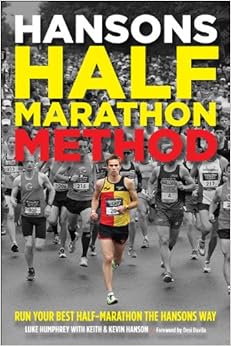This is the fourth in a series of summaries of the different aspects of
the Hansons' Half Marathon Method I'm using for my fall training. Others include easy runs, tempo runs, speed workouts, and long runs.
A few weeks into the half marathon plan, the speed workouts are replaced by strength workouts, which is the endurance-specific part of the plan.
"When strength workouts are added to the schedule, the goal of training shifts from improving the V02 max (along with anaerobic threshold) to maintaining the V02 max and preparing the body to handle the fatigue associated with endurance running. ...At the same time the strength segment begins, the tempo runs and the long runs become more substantial. At this point in the plan, everything the runner is doing is focused solely on half-marathon preparation.
Strength workouts are still runs, but ones that emphasize volume at a slightly lower intensity [than speed work], with the goal of stressing the aerobic system at a high level. While the speed sessions are designed to be short enough to avoid lactate accumulation (even though intensity is very high), the strength sessions are meant to force the runner to adapt to running longer distances with moderate amounts of lactate accumulation."
The benefits of strength workouts include improved lactate clearance, improved lactate tolerance, improved endurance at faster paces, improved oxygen delivery, and improved running economy--all developments that allow a person to run at a faster pace for a longer time.
These workouts are one of the main things that attracted me to this plan. Sure, speedwork is tough, but it's over quickly if you're doing 400s, 600s, or even 800s. Once of my biggest challenges in races is holding a tough pace for a longer time, so I love that these workouts are designed to help me get better at that.
The pace for these workouts is 10 seconds faster than goal race pace. So, if my goal race pace is 10:50, my pace for these workouts is 10:40. Why 10 seconds faster?
While you practice half-marathon pace with the tempo runs, the strength workouts are faster to get your body accustomed to the stress of lactic acid buildup, stressing the anaerobic threshold, which happens to coincide with the 10-second faster pace. This faster overall time will bring along with it a large increase in lactic acid. Even though the strength workout may not feel hard from an intensity standpoint, the volume, coupled with short recovery periods, is enough to stimulate lactic acid accumulation and make way for positive adaptations.
The workouts total 6 miles (plus recovery, warm-up, and cool-down), with each week progressing in length. For example, the first workout was 6 x 1-mile repeats, the second was 4 x 1.5-mile repeats, the third was 3 x 2-mile repeats, and the fourth is 2 x 3-mile repeats. That's the max, and then you work your way back down the ladder. My total miles on these workouts has been 9-9.5.
I've been reading a lot of reviews from other runners who used this plan, but all of them were for the marathon plan. Many runners thought that the pace of these workouts wasn't very hard, but they are going at 10 seconds slower than marathon place. Half-marathon pace is faster, thus the pace of these workouts is much faster. On my first workout, the 6 x 1-mile repeats, I didn't find the pace very hard, but as the repeats lengthened, I found the pace pretty hard. I mean, some of my 5K times are about 10:30, and 10:40 isn't much slower. In addition, these runs are done on Tuesday, which is the sixth consecutive day of running on the plan, so the body is pretty fatigued going into this workout. This morning I did the 3 x 2-mile repeats and it was the most difficult workout I've done so far on this plan. Holding that pace for a longer duration is really tough for me, but it's also exactly what I need to work on, so I can see the benefits.
As mentioned above, the strength workouts combined with longer tempo runs at race pace and longer long runs are the half-marathon-specific phase of training. The book says:
This final section of SOS (something of substance) training is meant to be difficult and leave you feeling somewhat drained. That being said, you've adhered to the principle of cumulative fatigue all along, so your body will be accustomed to handling new challenges on tired legs.
That's definitely the case with me. All of my SOS workouts are now very tough, and even running my easy runs on tired legs isn't easy, but I have the strength to get through all my workouts while still feeling pretty good. Labels: Hansons Half Marathon Method
